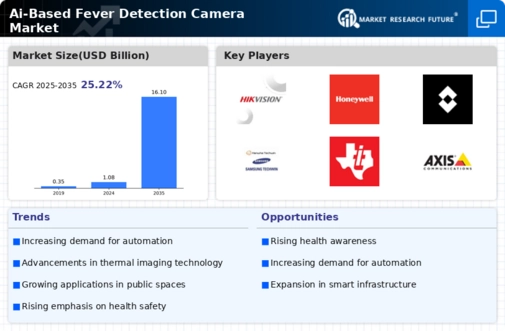Market Growth Projections
The Global Ai-Based Fever Detection Camera Market Industry is projected to experience substantial growth over the next decade. With a market value of 1.08 USD Billion in 2024, it is anticipated to surge to 16.1 USD Billion by 2035. This remarkable growth trajectory reflects a compound annual growth rate (CAGR) of 27.83% from 2025 to 2035. Such projections indicate a robust demand for AI-based fever detection solutions across various sectors, driven by technological advancements, regulatory requirements, and increasing health awareness. The market's expansion is likely to create opportunities for innovation and investment in this field.
Integration of AI in Security Systems
The integration of AI in security systems is transforming the Global Ai-Based Fever Detection Camera Market Industry. Organizations are increasingly recognizing the value of combining fever detection capabilities with existing security infrastructure. This integration allows for seamless monitoring and enhances overall safety measures in public spaces. By utilizing AI-driven cameras, businesses can automate temperature screening while maintaining security protocols. This dual functionality is appealing to many sectors, including retail and hospitality, as it streamlines operations and improves customer confidence. As a result, the market is poised for substantial growth, driven by this innovative convergence of technologies.
Government Initiatives and Regulations
Government initiatives and regulations play a crucial role in shaping the Global Ai-Based Fever Detection Camera Market Industry. Many countries are implementing policies that mandate temperature screening in public venues to ensure safety and health compliance. These regulations often require the installation of advanced fever detection systems in high-traffic areas. As a result, public and private sectors are compelled to invest in AI-based solutions to meet these standards. This regulatory push is expected to contribute to the market's growth, with projections indicating a rise to 16.1 USD Billion by 2035, reflecting the increasing importance of health security measures.
Growing Awareness of Health and Safety
The growing awareness of health and safety among the global population significantly impacts the Global Ai-Based Fever Detection Camera Market Industry. As individuals become more conscious of health risks, there is a heightened demand for technologies that can provide quick and accurate health assessments. This awareness drives organizations to adopt AI-based fever detection cameras as part of their health and safety protocols. The market's expansion is supported by the increasing emphasis on preventive measures in various sectors, including healthcare, education, and transportation. This trend is likely to sustain the market's growth trajectory in the coming years.
Technological Advancements in AI and Imaging
Technological advancements in artificial intelligence and imaging technologies significantly influence the Global Ai-Based Fever Detection Camera Market Industry. Innovations in machine learning algorithms and thermal imaging capabilities enhance the accuracy and speed of fever detection. These advancements enable cameras to analyze thermal data in real-time, providing immediate feedback and reducing the likelihood of false positives. As a result, organizations are increasingly investing in these sophisticated systems. The market is expected to expand rapidly, with a projected CAGR of 27.83% from 2025 to 2035, indicating a robust future for AI-driven fever detection solutions.
Rising Demand for Non-Contact Temperature Measurement
The Global Ai-Based Fever Detection Camera Market Industry experiences a notable increase in demand for non-contact temperature measurement solutions. This trend is driven by the growing need for efficient and accurate screening in public spaces such as airports, hospitals, and schools. As organizations seek to enhance safety protocols, the adoption of AI-based cameras becomes essential. In 2024, the market is projected to reach 1.08 USD Billion, reflecting a shift towards advanced technologies that minimize human interaction while ensuring reliable temperature assessments. This demand is likely to continue growing as public health awareness remains a priority.















